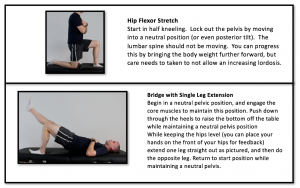Treating runners can be a difficult task. There are many types of injuries and they originate from a number of different areas. Is it a running form error? Is it weakness? Maybe something is too stiff? The number of possibilities is partially why so many runners struggle to return to activity. I discussed this breakdown in a previous post and how we use the ACE Running Movement Screen to identify the “weak link(s)”.
Here, I wanted to talk about the Unilateral Hip Bridge Endurance Test¹ and its amazing utility in runners with knee pain, back pain, and many other issues. If you’re not familiar with the test, you can watch me explain it below. On the surface, the test appears to be a simple test of the glute max, but as you look deeper, the knowledge you can gain from this is extraordinary.
The first step of the test is to perform a bilateral bridge. At this point you gain a few points of knowledge:
- Is the runner not able to lock out the hips? It could be strength. It could be a range of motion limitation.
- Does the runner hyperextend at the lumbar spine? This could be a clue into a motor control deficit that may contribute to back pain.
During the next step, the runner lifts one leg in a marching action. Again, you gain the next insight:
- Does the entire body drop in the sagittal plane? This points you towards the glute max in the sagittal plane.
- Does the pelvis rotate in the transverse plane? This points you towards an inability to control the pelvis in the transverse plane and it may show up in a runner who demonstrates a high level of excessive rotation during running.
A passing test would be the ability to perform the bridge with a leg lift, while maintaining a locked out hip and no deviation in the transverse and sagittal planes. Then you must hold this position for 10 seconds. Can you complete this seemingly simple task? If not, it could be a flag to work on with you or your runners.
If you aren’t using the Unilateral Hip Bridge Endurance Test as part of your screen with your runners and athletes, you can start now. You will find the best outcomes when it is used as part of a larger overall screening process, such as the ACE Running Movement Screen.
If you find the test difficult, try the corrective activities to the right. Once you get comfortable with performing the test, work on determining where the deficit is during the test. Was it motion? Was it strength? Was it something else? This will allow you to treat that athlete’s specific deficit and fix them more quickly!.
Want to learn more about running gait analysis and the ACE Running Movement Screen? Stay up-to-date on course offerings and receive tips on treating runners here.
- Butowicz CM, Ebaugh DD, Noehren B, Silfies SP. Validation of two clinical measures of core stability. IJSPT. 2016;11(1):15-23.